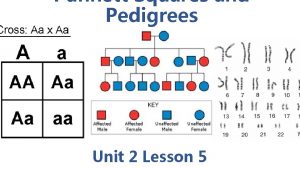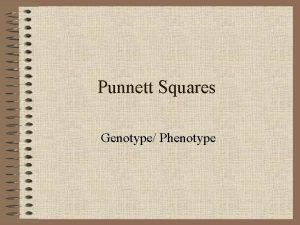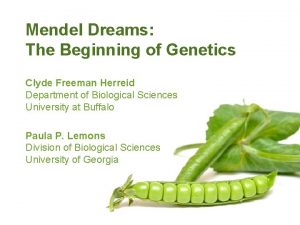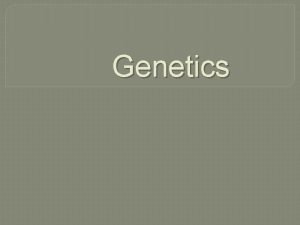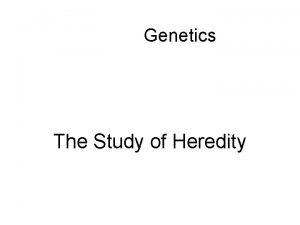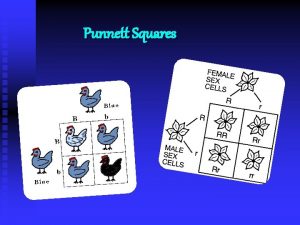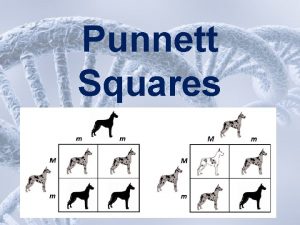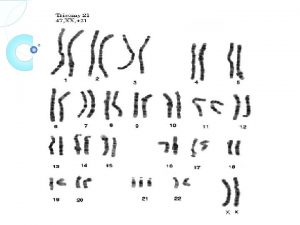Gregor Mendel and Punnett Squares Notes Gregor Mendel




















- Slides: 20

Gregor Mendel and Punnett Squares Notes

Gregor Mendel • Gregor Mendel was an Austrian monk who is the mid-nineteenth century began to study genetics. • Genetics – branch of biology that studies heredity. • Heredity- is the passing of characteristics from parents to offspring. • Characteristics that are inherited are called traits.

Examples of human traits are… • Eye color • Hair color • Height • Weight Basically everything that makes us, us!!! • Alleles—are different forms of a gene or trait; you get one copy from mom, one copy from dad ex. So if the trait is hair color, alleles could be brown or blonde. If the trait is plant height the alleles could be tall or short

What did he do? • Mendel used pea plants to see how traits are passed on from generation to the next. • He took pollen from pea plant and transferred to another. • This is called a cross pollination.

Mendel Studied 7 Different Traits Seed shape color Pod shape Plant height axial (side) green inflated tall terminal (tips) yellow constricted short Flower color position Dominant trait round yellow purple Recessive trait wrinkled green white

Mendel concluded that some traits are expressed more often than others. - Dominant trait– the observed trait, the tallness of a pea plant. - Recessive trait– the trait that seems to disappear, the shortness of a pea plant.

Mendel’s Law of Segregation • Mendel concluded in his law of segregation that every individual has two alleles of each gene. ( two forms of the same trait) • One from mom and one from dad • When gametes (egg and sperm) are produced, each gamete receives one of the two alleles.

• When using Punnett Squares, alleles are designated using letters. • The same letter is used for each trait. Dominant Trait = Capitol letter Recessive Trait = lowercase letter • The dominant allele is always written first.

An example would be: – The alleles for plant height could be written T = tall (dominant) t = short (recessive) In Mendel’s first cross… he crossed tall plants (TT) with short plants (tt) T= tall t= short - The alleles for hair color could be written B= brown (dominant) b= blonde (recessive) B= brown b= blonde

Examples!! Straight Hair S Curly Hair s Which one is the dominant trait? Tall Plants T Short Plant t Which one is the recessive trait?

Phenotypes and Genotypes Phenotype - The way an organism looks or behaves Genotype - An organism’s allele combination Examples: The phenotype of a tall plant is tall, it’s genotype can be TT or Tt. The phenotype of someone with light colored hair is blond, the genotype is bb.

Homozygous and Heterozygous Homozygous – when two alleles for a trait are the same. (both capitol or both lowercase) TT = has both alleles for tallness tt = had both alleles for shortness Heterozygous – when two alleles for a trait are different. (one capitol letter, one lowercase) Tt = has an allele for tallness (T) and an allele for shortness (t)

Practice • If T = tall and t = short • What’s the phenotype? – TT – TALL __________ – Tt TALL __________ – tt - short __________ • What’s the genotype? • Heterozygous tall Tt ____ • Homozygous Tall TT ____ • Homozygous short tt ____

Punnett Squares • Way to show possible genotypic and phenotypic outcomes for simple genetic crosses • Shows the probability for each outcome • There are two types: – Monohybrid cross-one trait crossed – Dihybrid cross – two traits crossed

P 1 generation—original parents F 1 generation—offspring of the parent plants (filial) • Ex. Your parents are P 1 and you are F 1 F 2 generation—offspring of the F 1 generation. Ex. Your children P 1 Short pea plant F 1 F 2 Tall pea plant All tall pea plants 3 tall: 1 short

Mendel’s Experiment • Mendel crossed a tall plant with a short plant and remember he got…. • The offspring in the 1 st generation were all tall (F 1 generation) • The offspring in the second generation, a tall and a short, were 75% tall and 25% short (F 2 generation) Why? What happened? You can do a Punnett Square to find out!!

Mendel’s Experiment Crossing tall homozygous dominant pea plants with short homozygous recessive. T = tall T T t =short t TT x tt (P 1) Offspring (F 1) Phenotype: 4/4 or 100 % tall Genotype: 4/4 or 100 % Tt t Tt Tt

Mendel’s Experiment In the next generation he got 3 tall plants and 1 short plant. Let’s see why. T = tall T t t =short T Tt x Tt (F 1) Offspring (F 2) Phenotype: 75 % tall, 25 % short Genotype: 25 % TT, 50 % Tt, 25 % tt t TT Tt Tt tt

Mendel’s Experiment • Crossing homozygous pea plants W=purple flower w=white flower W WW x ww W w Genotype: 4 Ww Phenotype: 4 purple 0 white w Ww Ww

• Crossing heterozygous pea plants W Ww x Ww w WW Ww Ww ww Genotype: 1 WW : 2 Ww : 1 ww Phenotype: 3 purple 1 white
 Gregor mendel punnett square
Gregor mendel punnett square How many squares
How many squares Who is gregor mendel and what is he famous for
Who is gregor mendel and what is he famous for Who is gregor mendel and what did he do?
Who is gregor mendel and what did he do? Pedigree
Pedigree Section 11-2 probability and punnett squares
Section 11-2 probability and punnett squares Section 11-2 probability and punnett squares
Section 11-2 probability and punnett squares 11-2 probability
11-2 probability Punnett square with percentages
Punnett square with percentages Damien thiesson
Damien thiesson Section 11-1 the work of gregor mendel
Section 11-1 the work of gregor mendel Who is gregor mendel
Who is gregor mendel Father of genetics
Father of genetics Rryy x rryy
Rryy x rryy Gregor mendel chart
Gregor mendel chart Chapter 12 lesson 1 the work of gregor mendel
Chapter 12 lesson 1 the work of gregor mendel Who is gregor mendel
Who is gregor mendel What did gregor mendel research
What did gregor mendel research What did gregor mendel do
What did gregor mendel do How many pairs of chromosomes do humans have? *
How many pairs of chromosomes do humans have? * Conclusion gregor mendel
Conclusion gregor mendel




